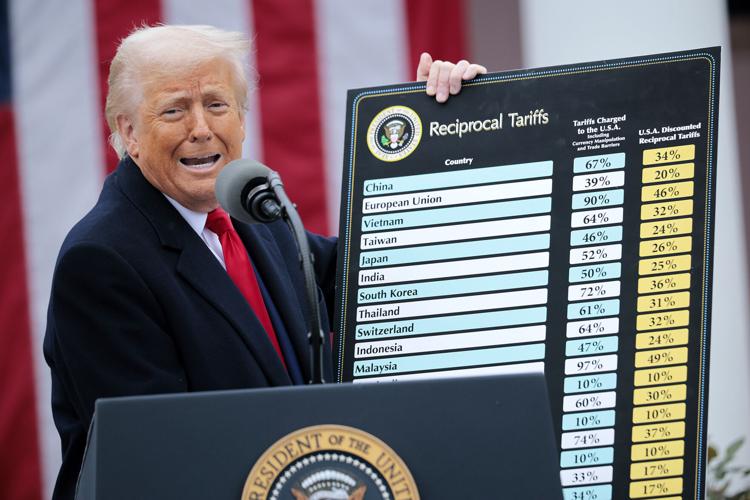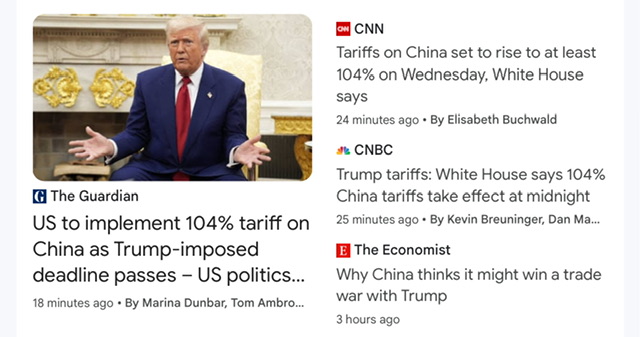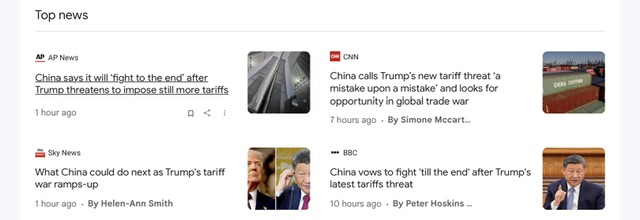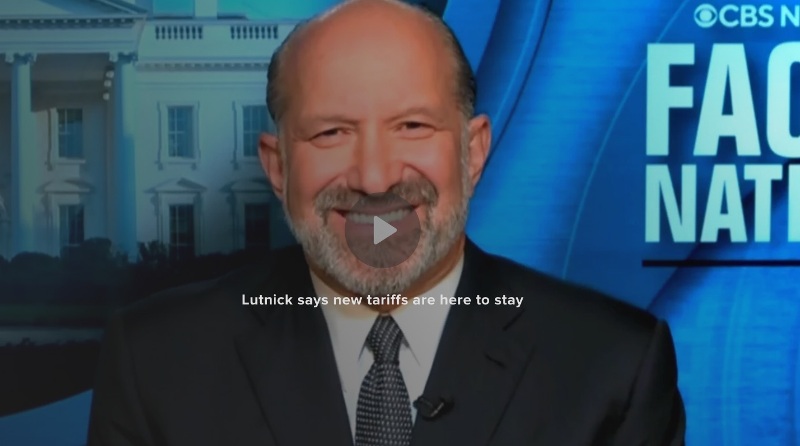Fact Checking a US-initiated Trade War
This week at an event in the Rose Garden of the White House the US president announced a global US policy of trade tariffs the he described as "liberation day" in the United States.
Here at GreenPolicy360 we have decided, as we consider worldwide impacts of this presidential decision, to launch a new webpage -- "Fact Checking a US-Initiated Trade War". The impacts and consequences of what is already being described in news headlines as a Trade War deserves its own page and so here we go...
A US-initiated trade war, an updated 'neo-mercantalism' is a new use for an old policy, a belief expressed by the current president that the presidency of William McKinley in the late 1800s, a time of tariffs and protectionism, was a golden age. (Others called this era of the late 1800s the "Era of the Robber Barons" and a corrupt "Gilded Age".) President Trump's new direction in this sense is an old direction that was abandoned after Smoot-Hawley tariffs in the 1930s led to a Great Depression, escalating national conflicts, and World War.
The Republican party under Trump is now returning to nationalistic, protectionist policies from the past. We will see, in actions and responses, how it turns out this time.
One thing can already be said about tariffs of the 21st century. Facts will tell the tale. Large and small there will be costs and benefits, pluses and minuses, pros and cons. As the facts of a Trump-era Trade War come into view, all nations will experience a new world and we will look closely at and beyond Gross National Product/Gross Domestic Product (GNP/GDP) to reveal deeper changes.
On this page we will go 'down a rabbit hole', as the saying goes, and explore the consequences of the Trump tariffs, trade barriers, taxes and threats. The consequences of the Trump Trade War extend far beyond trade and will bring on a reset of how the countries of the world see and deal with the United States ...
__________________________
Tariffs give Trump a unilateral power to punish and reward businesses as he sees fit.
Now each country hit by Trump tariffs will have to come before the president and negotiate, or accept a fait accompli, a done deal, or take another more 'multifaceted' approach. All is up for discussion. Across the political spectrum, countries are talking of confronting 'bullying'.
__________________________
Associated Press / April 2, 2025
Trump, in a Rose Garden announcement on Wednesday, said he was placing elevated tariff rates on dozens of nations...
Trump’s Misleading Tariff Chart
In his Rose Garden announcement of sweeping new “reciprocal tariffs,” President Donald Trump held aloft a misleading chart that claimed to give a breakdown of the tariffs other countries charge the U.S. and the corresponding tariff that the U.S. will now impose against those countries...
Economists told us that’s not a legitimate way to calculate reciprocal tariffs for countries.
“Those listed numbers are simply not tariffs, but some other made-up measure based on a formulaic trade deficit calculation,” Kimberly Clausing, a nonresident senior fellow at the Peterson Institute for International Economics, told us via email. “In almost every instance, countries’ true trade barriers are far, far lower.”
“This is not a legitimate way to calculate trade barriers, and the vast majority of subject matter experts (I would wager >99% of international economists) would reject this methodology as profoundly flawed.”
Money in Politics
○
April 8, 2025
The US Vice President's description of China's population 'goes viral' in China
April 7, 2025
How Trump’s Tariffs Play Right Into China’s Hands
Commentary (Via 'On the Ground' Observations)
By Thomas Friedman
NY Times / April 7, 2025
After two trips to China in the last four months, I’ve been trying to say this every way I know how: Folks, you just don’t understand.
Covid had terrible effects on human health and mortality, but it also had a terrible effect on our ability to understand China. American and European business executives left China in droves at the start of the pandemic. Very, very few of them ever went back afterward. They entrusted their China businesses to local managers. While they were gone, Beijing took a great leap forward in advanced manufacturing that the world missed. It has created a manufacturing engine the likes of which may never have been seen in history.
China already controls one-third of all global manufacturing (up from 6 percent in 2000), and whether you are talking about cars or robots or phones, what is coming out of China today is not just cheaper and faster. It is cheaper, faster, better and smarter — and it is all about to be dramatically supercharged by China’s headlong rush to put artificial intelligence into everything it makes.
This engine is the product of decades of massive government investments in education, infrastructure and research, behind walls of protection — in a society where people are ready to work from 9 a.m. to 9 p.m., six days a week. While China was building that, America’s biggest new industry was political polarization and getting its children addicted to TikTok and Instagram.
>Recent data from China’s central bank shows that state-controlled banks lent an extra $1.9 trillion to industrial borrowers over the past four years. On the fringes of cities all over China, new factories are being built day and night, and existing factories are being upgraded with robots and automation. China’s investments and advances in manufacturing are producing a wave of exports that threatens to cause factory closings and layoffs not just in the United States but also around the globe.
Read More:
~
China says it will 'fight to the end' after Trump threatens 50% higher tariffs
China’s Commerce Ministry said it “resolutely opposes” U.S. President Donald Trump’s threat of escalating tariffs, and vowed to take countermeasures to safeguard its own rights and interests.
The comments came after Trump said he would impose an additional 50% duty on U.S. imports from China Wednesday, if Beijing does not withdraw the 34% tariff it imposed on American products last week.
“The U.S. threat to escalate tariffs on China is a mistake on top of a mistake,” the statement said, according to a CNBC translation. “China will never accept it. If the U.S. insists on its own way, China will fight to the end.”
~
China denounces as 'blackmail' Trump's threat to ratchet tariffs higher
"The U.S. side's threat to escalate tariffs against China is a mistake on top of a mistake, once again exposing the American side's blackmailing nature," China's commerce ministry said in a statement.
"If the U.S. insists on having its way, China will fight to the end."
~
U.S. stocks ended another tumultuous day lower as markets reeled from President Donald Trump’s latest threats to crank his tariffs higher.
The S&P 500 sank 0.2%. The Dow Jones Industrial Average fell 349 points. The tech-heavy Nasdaq Composite closed little changed.
~
The S&P 500 has declined nearly 14% since Mr. Trump unveiled the latest tariffs last week, while the blue-chip Dow is down 12%. The Nasdaq has decreased nearly 16% over that period, putting the tech-heavy index in a bear market — when stocks fall at least 20% from their most recent high.
Asia-Pacific stocks from Shanghai to Tokyo and Sydney to Hong Kong plunged on Monday by levels not seen in decades, as global markets continue to reel from US President Donald Trump's tariffs.
~
Volatile Monday
US stocks were tumbling, surging and then bouncing around in every direction, as traders searched for any sign that President Donald Trump’s tariffs could be negotiated or halted.
Markets around the world had tumbled earlier in the day over concerns about how Trump’s sweeping tariffs might upend the global economy and stymie economic growth. US stocks opened the day in bear market territory but surged an hour later on rumors that the Trump administration may pause tariffs — perhaps for several months.
That rumor turned out to be just that — a White House official called any suggestion that Trump would pause tariffs “fake news.”
~
Donald J. Trump @realDonaldTrump
Apr 07, 2025 at 11:14 AM
Yesterday, China issued Retaliatory Tariffs of 34%, on top of their already record setting Tariffs, Non-Monetary Tariffs, Illegal Subsidization of companies, and massive long term Currency Manipulation, despite my warning that any country that Retaliates against the U.S. by issuing additional Tariffs, above and beyond their already existing long term Tariff abuse of our Nation, will be immediately met with new and substantially higher Tariffs, over and above those initially set. Therefore, if China does not withdraw its 34% increase above their already long term trading abuses by tomorrow, April 8th, 2025, the United States will impose ADDITIONAL Tariffs on China of 50%, effective April 9th. Additionally, all talks with China concerning their requested meetings with us will be terminated! Negotiations with other countries, which have also requested meetings, will begin taking place immediately. Thank you for your attention to this matter!
~
Goldman Sachs now forecasts there is a 45% chance the US will fall into recession in the next 12 months - up from a previous estimate of 35% - as the investment banking giant lowered its economic growth forecast for the country.
Other Wall Street firms have also revised their recession forecasts in the wake of Trump's tariff announcement. JPMorgan now sees a 60% chance of a US and global economic downturn.
○
Howard Lutnick, United States Secretary of Commerce
* https://en.wikipedia.org/wiki/Howard_Lutnick ... https://greenpolicy360.net/w/File:Lutnick_promises_the_new_Trump_tariffs_will_remain.jpg
April 6, 2025
- https://cleantechnica.com/2025/04/05/china-just-turned-off-u-s-supplies-of-minerals-critical-for-defense-cleantech/ (A trade war move)
- https://www.axios.com/2025/04/06/trump-tariffs-error-aei (More than a math error)
Public Pushback
News of several million people in more than 1,000 communities across America in protest demonstrations against Trump
○
April 5, 2025
Economic Impact and Market Reaction to Trump's Tariffs
US stock markets have been falling for two days now, wiping out vast sums from investment and retirement portfolios.
Fed Chairman Jerome Powell has also warned that these tariffs would result in "higher inflation and lower growth."
The Dow Jones was down 5.5% and the S&P 5.97%.
Since Trump declared his "Liberation Day" tariffs, US financial markets have reportedly lost over $6 trillion.
○
April 4, 2025
"International trade and investments will suffer and global growth will slow... the last time the world experienced something like this was in the 1930s. Trade wars escalated into armed conflict, and eventually the Second World War. No one can say how the current situation will unfold in the coming months... but we must be clear-eyed about the dangers that are building up in the world." -- Lawrence Wong, Prime Minister, Singapore
Sampling Reactions
Media statements to remember
Wall Street Journal
After the mid-week announcement, Wall Street was plunged into a two-day rout that erased $6.6 trillion in stock-market value. Trump on Saturday morning urged Americans to stay the course through what he called an economic revolution.
Barron's
When it comes to tariffs, Donald Trump holds all the cards. The launch of tariffs against virtually every other nation on April 2 finds Trump unleashed. As a second-term president whose party has been reshaped by his movement, he is free to follow his political instincts. And those instincts are leading him, and the world, straight into economic warfare.
China News
Beijing said the U.S. action “seriously undermines China’s legitimate rights and interests” and labeled it “a typical unilateral bullying practice.” With approval from the State Council, China confirmed it will add a 34% tariff to every U.S. import arriving after April 10 at 12:01 a.m.
○
April 3, 2025
A Trump family prediction
“I wouldn’t want to be the last country that tries to negotiate a trade deal with Donald Trump. The first to negotiate will win – the last will absolutely lose. I have seen this movie my entire life...” -- Eric Trump
○
April 2, 2025
And so it starts...
On April 2, 2025, a day he called "Liberation Day", Trump signed an executive order imposing a minimum 10% tariff on all U.S. imports, with limited exceptions. Imports from 57 nations and entities will face higher tariffs, ranging from 11% to 50%. The general tariffs took effect on April 5, 2025, while the elevated tariffs are scheduled to begin on April 9, 2025. These controversially named "reciprocal tariffs" prompted retaliation from global trade partners and triggered an immediate stock market decline.
○





